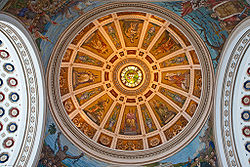
Capitol of Puerto Rico
Encyclopedia

Puerto Rico
Puerto Rico , officially the Commonwealth of Puerto Rico , is an unincorporated territory of the United States, located in the northeastern Caribbean, east of the Dominican Republic and west of both the United States Virgin Islands and the British Virgin Islands.Puerto Rico comprises an...
is located on the Islet of San Juan just outside the walls of Old San Juan. The building is home to the bicameral Legislative Assembly
Legislative Assembly of Puerto Rico
The Legislative Assembly of Puerto Rico is the territorial legislature of the Commonwealth of Puerto Rico. The structure and responsibilities of the Legislative Assembly are defined in Article III of the Constitution of Puerto Rico....
, composed of the House of Representatives
House of Representatives of Puerto Rico
The House of Representatives of Puerto Rico is the lower house of the Legislative Assembly of Puerto Rico, the territorial legislature of Puerto Rico...
and Senate
Senate of Puerto Rico
The Senate of Puerto Rico is the upper house of the Legislative Assembly of Puerto Rico, the territorial legislature of Puerto Rico. The Senate is composed of 27 senators, representing eight constituent senatorial districts across the commonwealth, with two senators elected per district; an...
. The building is located in the Puerta de Tierra sector of San Juan
San Juan, Puerto Rico
San Juan , officially Municipio de la Ciudad Capital San Juan Bautista , is the capital and most populous municipality in Puerto Rico, an unincorporated territory of the United States. As of the 2010 census, it had a population of 395,326 making it the 46th-largest city under the jurisdiction of...
.
The Capitol is also commonly referred to as the Palace
Palace
A palace is a grand residence, especially a royal residence or the home of a head of state or some other high-ranking dignitary, such as a bishop or archbishop. The word itself is derived from the Latin name Palātium, for Palatine Hill, one of the seven hills in Rome. In many parts of Europe, the...
of Laws .
History
The idea of constructing a capitol was first introduced by former Resident CommissionerResident Commissioner of Puerto Rico
The Resident Commissioner of Puerto Rico is a non-voting member of the United States House of Representatives elected by the voters of the Commonwealth of Puerto Rico every four years...
Luis Muñoz Rivera
Luis Muñoz Rivera
Luis Muñoz Rivera was a Puerto Rican poet, journalist and politician. He was a major figure in the struggle for political autonomy of Puerto Rico....
in 1907, and was partly meant to demonstrate some degree of civilian rule in the island, which at the time was a colony of the United States
United States
The United States of America is a federal constitutional republic comprising fifty states and a federal district...
. Construction of the building eventually began in 1919 under the leadership of Antonio R. Barceló
Antonio R. Barceló
Antonio Rafael Barceló y Martinez was a lawyer, businessman and the patriarch of what was to become one of Puerto Rico's most prominent political families...
. The building was inaugurated on February 11, 1929, with the first meeting of the Legislative Assembly taking place three days later.
It was listed on the U.S. National Register of Historic Places
National Register of Historic Places
The National Register of Historic Places is the United States government's official list of districts, sites, buildings, structures, and objects deemed worthy of preservation...
in 1977 as El Capitolio de Puerto Rico.
Building complex
Over the designed in the 1950s by the Toro-Ferrer architectural firm: the Rafael Martínez Nadal Senate Annex on the Senate side and the Ernesto Ramos AntoniniErnesto Ramos Antonini
Ernesto Ramos Antonini was the President of the House of Representatives of Puerto Rico and co-founder of the Partido Popular Democrático de Puerto Rico .-Early years:...
House Annex on the House side. The Luis Muñoz Marín
Luis Muñoz Marín
Don José Luis Alberto Muñoz Marín was a Puerto Rican poet, journalist, and politician. Regarded as the "father of modern Puerto Rico," he was the first democratically elected Governor of Puerto Rico. Muñoz Marín was the son of Luis Muñoz Rivera, a renowned autonomist leader...
Senate Office Building houses administrative and committee offices, the Luis A. Ferré
Luis A. Ferré
Don Luis Alberto Ferré Aguayo was a Puerto Rican engineer, industrialist, politician, philanthropist, and a patron of the arts. He was the third Governor of the Commonwealth of Puerto Rico from 1969 to 1973, and the founding father of the New Progressive Party which advocates for Puerto Rico...
Building houses offices for both chambers, as well as a 700 space parking garage, while the Antonio R. Barceló
Antonio R. Barceló
Antonio Rafael Barceló y Martinez was a lawyer, businessman and the patriarch of what was to become one of Puerto Rico's most prominent political families...
Building houses offices for both chambers, the Legislative Library, and offices for the Superintendent of the Capitol and the Office of Legislative Services
Office of Legislative Services of Puerto Rico
The Office of Legislative Services of Puerto Rico was created on January 27, 1954 to provide research, translation, library and legislative drafting services to all members of the Puerto Rico Legislative Assembly. Its duties are similar to those of the Congressional Research Service.The Office is...
. The Ramón Mellado Parsons Building houses Senate offices. The buildings that formerly housed the State Commission of Elections in Puerta de Tierra are currently used to house Senate and House archives, as well as administrative offices.

